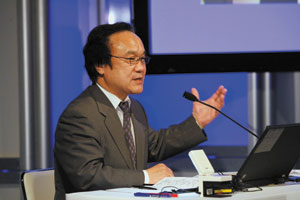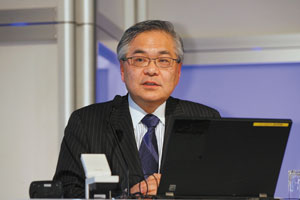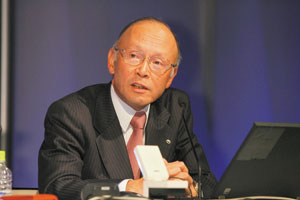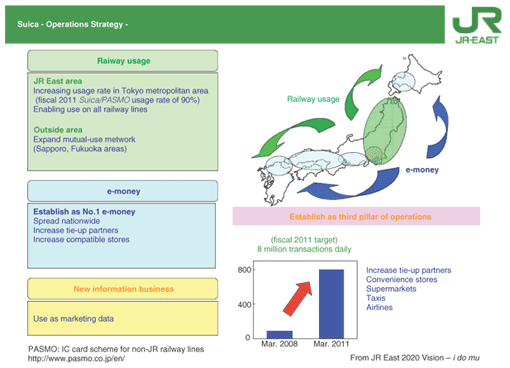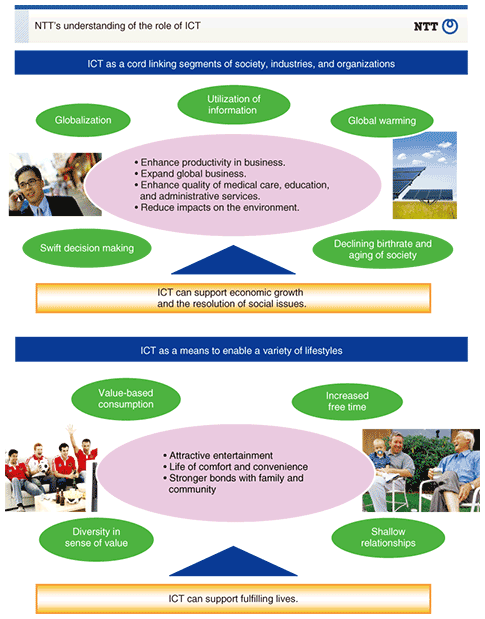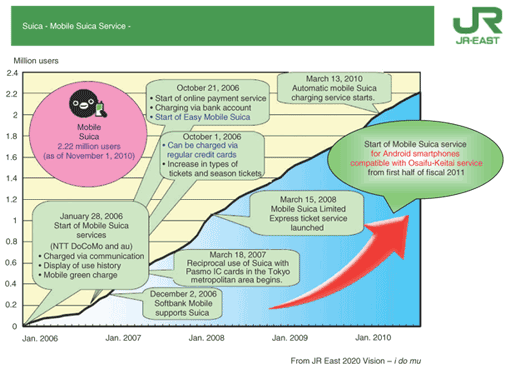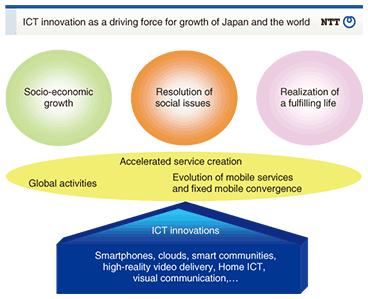 |
|||||||||||
|
|
|||||||||||
|
Feature Article: NTT R&D Forum 2011 Panel Discussion Vol. 9, No. 5, pp. 6–15, May 2011. https://doi.org/10.53829/ntr201105fa1 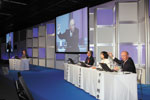 Creating a Vigorous Society and a Richer Future with ICT––Innovations in Lifestyle and BusinessCoordinator:Panelists:AbstractDuring the NTT R&D Forum 2011, a panel discussion entitled “Creating a Vigorous Society and a Richer Future with ICT” was held (ICT: information and communications technology). Noritaka Uji, Senior Executive Vice President, participated as a panelist. This article reports on the discussion between the coordinator and panelists.
1. IntroductionSekiguchi: I believe that we are all fully aware of how the Internet and new information technology called social media, such as Twitter and Facebook, gave impetus to the current movements toward democracy that are taking place in certain Middle Eastern countries. The challenge we face today is how to make the most of this new technology. Today, we intend to discuss that challenge under the theme of “Creating a Vigorous Society and a Richer Future with ICT” (ICT: information and communications technology). We are fortunate to have three panelists who are eminently qualified to discuss this topic. We will start with a brief presentation by each panelist and then move on to a panel discussion. 2. PresentationsICT as a powerful driving force for dramatic evolution of enterprisesTomita: The railway industry has long been a leading-edge ICT industry. I’m sure you’re familiar with railway signals. They show whether there is a train ahead of you or whether it is safe to proceed. This is a core technology for ensuring safety. It is the culmination of a progression of painstaking efforts that have been made since the inception of rail transport in Japan, in 1872. This is truly an ICT. The latest example of ICT use in railway operations is an IC (integrated circuit) ticket called Suica. [4] To date, 33 million Suica cards have been issued. Of these, 31 million can also be used as electronic money, and some 2.3 million e-money transactions take place every day. To ensure further development of Suica, we believe that it is important to achieve interoperability with the IC tickets issued by other railway companies throughout Japan (Fig. 1). We are also planning to expand Mobile Suica services, which enable Suica functions to be used with a mobile phone, by the summer of 2011 with a view to linking with Android smartphones that are compatible with Osaifu-Ketai (an electronic wallet scheme for mobile phones [5]) so that payment for Internet shopping can be done using Suica. The linking of Suica with Android smartphones will enhance Suica’s capability as a convenient payment facility for online shoppers.
We are considering exploiting ICT to create a railway system that does not rely on signals. Currently, a train’s location is identified by sending an electric current along the rails to create a track circuit and measuring the current in that circuit. Signals are then controlled on the basis of the identified train locations, and train operation relies on those signals. It will soon be possible to use wireless technology, instead of track circuits, to determine train locations. Instructions about the running speed and direction of each train can be sent using wireless communication. This will make it possible to dramatically reduce both facilities on the ground and maintenance costs. The energy consumption and overall costs of operating the railway system can also be reduced and safety will probably be further enhanced. We want to achieve a breakthrough in railway operation by using such technologies. Opportunities for people to learn various viewpointsSasaki: In 2000, we created a website called ewoman, which serves as an information hub. We believe that ICT is not just about convenience but about helping people to develop. The Internet is more than a tool for disseminating information; it’s a tool for building a knowledge database. Users can search the database for information and consider how to make appropriate use of the obtained information. For example, the ewoman site provides ewoman’s online roundtable discussion. This is not a bulletin board for posting information; there is a chairperson to coordinate a four-day discussion in each round table, and the resulting information is rearranged for readers. Users can access past discussions in order to learn about the subject matter discussed from various perspectives. To make the database really useful for readers, we have introduced what we call the I-statement rule. Participants must limit their statements to matters that directly concern them. In other words, instead of presenting general statements, they are required to discuss their own specific views and experiences. The intention is to eliminate hearsay and generalized discussions and to enable readers to understand a range of perspectives. I believe that forums of this type will be necessary in the coming age of diversity. We can create new value by integrating technology and knowledge. What can we do with ICT? How should we use it? It is important that ICT goes beyond merely providing convenience; it must enable people to learn and grow. To create a true knowledge database, it is important to ensure interactivity and encourage participants to think in the first person. It is not enough that people can access the database. The database should enable them to broaden their options, make life more fulfilling, and enhance their sense of ethics. ICT supports socio-economic growth, resolution of social problems, and pursuit of fulfilling livesUji: In this forum, a variety of ways of exploiting the latest technology are being exhibited. Let me talk about our fundamental approach to ICT. We think that ICT is a cord linking different segments of society, industries, and organizations. For example, in an enterprise, ICT links different departments, such as sales, development, and general affairs. It also links different industries, or different ministries and agencies of the national government. It plays the role of holding things together. Linking different segments can enhance productivity and expedite transactions in business, for example. As we face various social issues, such as the declining birthrate and aging society, we urgently need to make full use of ICT in the fields of medical care, education, and administrative services in order to enhance the quality of these services. In this way, ICT can contribute to economic growth and the resolution of social problems. Another role for ICT is making possible a variety of lifestyles. We believe that ICT can support fulfilling lives by making it possible to strengthen the bonds within families and within communities (Fig. 2).
The latest keywords these days are clouds and smartphones. For example, studies are underway on a collaboration model whereby video coverage of work being conducted in the field can be recorded on a smartphone and sent to a remote office, which can then give visually oriented instructions to workers in the field in real time. This could dramatically enhance work efficiency. A new mechanism can be developed whereby a cloud manages smartphones in such a way that losing your phone is not longer a major inconvenience. The previous panelist talked about a knowledge database. I believe that the accumulation of large volumes of data in clouds can lead to the creation of new value for society. Need for an ICT policy that emphasizes better use of informationSekiguchi: As mentioned by one of our panelists, it will become common for terminals, such as tablet terminals, to be connected to clouds. The user will store his or her data in clouds and access the clouds to retrieve data via any available terminal. The advent of clouds and smartphones is making such a lifestyle possible. The time is coming when data clouds will be provided as a utility service like electricity, gas, and water. Faced with this prospect, people are expressing concern about how to ensure security and privacy. We need to ask ourselves how we should deal with these issues. If we pause to look around, we can observe many changes taking place in the world, and we realize in what respects Japan is lagging behind. I think that there are three stumbling blocks that may impair our ability to achieve innovation. The first of these is what some Japanese refer to as the Galapagosization of Japan, meaning that certain technologies used in Japan are unique, like the species whose habitat is confined to the Galapagos Islands, so they can never become global standards. It is true that Japan has had many good technologies. However, that is meaningless unless they are actually used. If our technologies are not well accepted globally, we will never get past a sense of being somewhat isolated. The second stumbling block is people’s general misgivings regarding the protection of personal information. To fully exploit information technology for the benefit of people’s lives, we must have a common infrastructure. The idea of assigning an ID (identity number) to every Japanese citizen has never advanced beyond the discussion stage. I believe that Japan urgently needs to put this idea into practice. Third is the tendency to demand excessive protection of copyrights. It is, of course, important to protect intellectual property rights, but I believe that we now need to adopt an ICT policy that places more emphasis on enabling people to better use copyrighted information than on rigorously protecting copyrights. 3. DiscussionHow to promote globalization of Japan’s technologies and servicesSekiguchi: At this point, I would like to ask the panelists to discuss what type of information society we should aim at creating. Although I think that Suica is an excellent technology, when I go abroad, I find completely different systems in use. Suica would seem to be one of those Galapagos species. Do you have a strategy for expanding its application overseas and, if so, could you share it with us? Tomita: Now that Suica is well accepted in Japan, we are exploring ways to expand its use overseas. However, there are a couple of issues to consider. The first is the data transmission speed. Commuters in Japan walk very fast. They pass through a ticket gate at about 1.5 m/s, probably the fastest rate in the world. Therefore, the Suica system must also operate very fast. It both reads and writes data in less than 200 ms. In Europe and the USA, such high-speed operation would be regarded as over-specification. The second issue is reliability. Suica ensures system reliability by storing data in three different places—in the central equipment, in the ticket gate machine, and in the Suica card—so that any lost data can be found in a backup. Potential customers overseas regard such an intensive backup system as unnecessary. Even where we have an excellent technology in Japan, when we attempt to transfer it to another country, we need to examine whether or not the technology is appropriate for the specific situation of the target country. I often feel that we should not be complacent about having an excellent system. Sekiguchi: I think that we should make greater efforts to have Japanese technology accepted globally as a de facto standard. What do you think? Tomita: We should not be the only ones to bear the burden of those efforts. We cannot make any progress in that direction unless the whole country becomes involved in thinking about how we should develop smartcards and the systems that use them. Unfortunately, there seems to be a gap in perception between Japan and other countries about the value of the convenience provided by smartcards. How to bridge that gap is another difficult issue. However, I believe that, by linking the Suica system with smartphones (Fig. 3), you can develop cards and terminals that are suitably tuned to individual users’ needs. Provision of such sophisticated services can create new value.
Uji: I think it is great that Suica is built into a mobile terminal and enables user identification to be used in setting up communication. Initially, a single smartcard cost about 10,000 yen. Over time, the price has dropped dramatically. That is also great. The smartcard used to authenticate a cigarette vending machine user has fewer functions than other smartcards because it was paramount to reduce the price of this type of card. The capabilities built into a smartcard should be closely linked to how and where it is to be used. It is necessary to consider whether there is greater demand for less expensive cards or for highly secure cards. A highly sophisticated card cannot be a panacea for all needs. Sasaki: I recall a conversation that I had with some local people during a recent visit to Switzerland. I showed them how my mobile phone receives information about what time my son passed through which exit of which station because he used his student commuter pass smartcard at a ticket gate. Their reactions surprised me. “What are you doing?” “That’s wrong.” When I raised the issue of children’s safety in public places, they responded: “Your way of thinking is wrong.” We then had a lengthy discussion. This demonstrates that service needs vary depending on the specific environment and sense of values. What is required of a system can vary depending on whether you are targeting only the Japanese domestic market or aiming for global market acceptance. Sekiguchi: I agree that, while technology may be global in nature, the services that people want will have a very local character. So, it would seem that the question we need to consider is how to intelligently balance the global and local aspects of a particular technological offering. Use of social media in enterprisesSekiguchi: As I noted at the outset, we are witnessing a surge in the use of social media. However, in Japan, enterprises in particular seem to take these media channels with a grain of salt. What’s your perception? Sasaki: I think that the potential power of individuals being able to speak out is clearly an extraordinary development, as evidenced by events in the Middle East. Previously, a person’s opinion travelled slowly. Today, individuals access the Internet to post a variety of information from wherever they happen to be. Social network services (SNSs) on the Internet, for example, have developed into powerful tools. What is important in this Internet era is that individuals have a sense of ethics, a sense of responsibility in expressing their opinions, information literacy, and the ability to use and combine information. Japanese enterprises are not even ready to experiment with SNSs. They are still watching these systems from a distance with suspicious eyes. Some enterprises are reluctant to set up inquiry links on their websites. The moment some of them did, they received a flood of complaints and had to shut down the links because they could not deal with the volume. I suspect that, if enterprises feel threatened by the notion of setting up inquiry links, they simply wouldn’t know what to do if their employees were to begin speaking out via an SNS. What enterprises should do is enhance employee satisfaction and train their people in public relations and communications so that they can serve as company spokespersons. Instead of restricting their employees’ opportunities to speak out, enterprises would do better and enjoy enhanced brand perception if they were to train their employees to become good publicists. Sekiguchi: A case in point is what happens when a train service is resumed after a period of temporary service suspension. It is Twitter users who transmit, ahead of all other media, the news that the trains are running again. Leaving aside the matter of whether or not such information is accurate, social media transmit information earlier than any official service. How does JR East deal with this issue? Tomita: This is a major issue. In principle, information about an accident or delay should be disseminated through the mass media. If we do not notify reporters in the mainstream press first, our good relations with them will suffer. So, we must be careful when issuing information. Although the idea you mention is one possible way of sending information, it involves a difficult problem. It is true that social media can transmit information faster. They can be effective tools. JR East has some 60,000 employees. A social network could be effective for mutual communication and exchange of information between employees. Sekiguchi: What is the position of the ICT service provider on this issue? Uji: Although we are a provider of ICT services, we are also users of these services. So, let me speak from the user perspective. NTT DATA has a web page for disseminating internal information. It also operates an internal social media mechanism through which employees can communicate freely across different departments and across different ranks. The mechanism is used effectively to communicate employees’ opinions about understanding user needs and to provide mutual support. NTT Laboratories also has an SNS called chie-no-wa, which operates across the boundaries between organizations within the Laboratories. It is very useful for exchanging technical information and unearthing new ideas. In addition, employees in the Public Relations Department of NTT Holding Company are tweeting for the public. This is highly rated as a new approach to public relations. The NTT Group has some 200,000 employees and the number of overseas employees will increase. We will need to study, on the fly, how to use social networks while also seeking to ensure compliance. How to deal with privacy and security in the age of high utilization of informationSekiguchi: The technology research company Gartner conducts an annual survey of chief information officers (CIOs). It asks them to define the most important issue for their respective companies. Responses naturally include such considerations as cost reduction, improved efficiency in the supply chain, and quick decision-making, but the one that is attracting growing attention is greater use of social media. CIOs are increasingly concerned about how to facilitate information exchange with customers, employees, and other stakeholders. However, if we look at what is happening in the Middle East and at the WikiLeaks story, we can see that efforts to facilitate communication are, in a way, rebounding on those who have promoted such efforts. Even though you might have completely protected yourself against external attacks, you may not have taken sufficient measures to prevent information leakage from the inside. While the sharing of information is important, I think it is necessary to control information wisely. What do you think? Tomita: That is an issue that we need to address seriously. JR East currently has some 100 companies in its group. Each company has its own website and its own system for exchanging information over the Internet. We have begun to check the levels of security and information management of these systems. We are exhaustively checking whether adequate defensive steps are being taken to protect servers and terminals against not only attacks from outside the company but also information leakage from the inside and whether or not logs are kept. Sekiguchi: While system developers need to take this issue seriously, I think that each employee or each individual should also ensure that he or she takes measures to prevent his/her personal information from being disclosed in an undesirable manner. Sasaki: When I read the blogs or twitters of well-known figures, I am puzzled when they write “I’m on the platform of such and such station” or “I am going into the restaurant of such and such hotel.” Are they inviting people to come over or informing people that here is a chance to attack them? I am always careful to avoid risk when I tweet. Today, with so many people able to post information and access each other’s information, it is necessary to enhance users’ behavior and their ability to judge what is confidential and whom they need to protect in addition to implementing advanced security technology. Risk management and security education for users is just as important as security technology. Security policy that considers active utilization of informationSekiguchi: Japanese companies tend to treat all kinds of information as confidential or classified. This results in a situation where you can no longer tell which information really is sensitive. Uji: The higher the barrier to information access, the harder it is to make good use of that information and ensure that it is widely used. On the other hand, if access to information is not controlled at all, there is a risk of information leakage. I think that it is the role of enterprise security policies to clarify these issues. We have established a security policy and provided tools and a mechanism for implementing the policy, such as requiring employees to hold their employee ID cards close to a contactless card reader, which reads the IC in the card, when they start up their personal computers in the office and classifying information in terms of the required security level. While we undertake research and development of technologies to enhance information security, our recognition that it is important to classify information has led to establishment of the security policy. While it is necessary to protect the confidentiality of information, it is also important to promote active use of information. For example, an NTT Group company provides an online question answering service called Oshiete, goo!. When someone submits a question on this website, he or she gets answers. As people discover the convenience of this service, the number of users is increasing and more and more information is being accumulated, creating a virtuous cycle. This is indeed a database of knowledge. I think that the provision of such a service represents the cloud concept in its broadest sense. The time has come for us to benefit from such convenient services. Technology has come a long way. Sekiguchi: So, the two mainstays are construction of watertight systems and establishment of a watertight security policy. Even so, problems can occur. There can be pitfalls anywhere in the information society. This is a risk management issue. Given the security and privacy issues that we are faced with, how can we build a trouble-free system? Uji: I believe that mechanisms in which appropriate security and privacy measures are implemented will increasingly find their ways into enterprises and everyday living. For example, service characteristics required in the medical, educational, and administrative fields vary from service to service. Some services can be provided on a best-effort basis. Some require rigorous authentication of users. Some cannot tolerate temporary service interruption. The NTT Group has declared that it will provide clouds that serve as safe and secure social infrastructures. In this respect, I believe that we must broaden their utilization in services of the Next Generation Network (NGN), which combines the convenience of the Internet with the reliability of the telephone network. Need for interpreters to facilitate communicationSasaki: I think that we now need interpreters to facilitate communication between those who know systems and those who know business processes. While we want to hear feedback from users, we sometimes fail to understand what they are telling us. Here’s an interesting anecdote. When female users said that they wanted a cuter product, the developer assumed that they meant the product should be pink. In fact, to the women, something cute meant a product with rounded edges. Enterprises need to recognize that proper interpretation is very important. Now that it’s so easy for individuals to post information, as in the case of SNSs, media training for consumers is also important. Our company provides media training to enterprise executives. It will also become necessary to provide media training to employees so that they can communicate their business processes and advanced technologies in a manner that users find easy to understand and so that they can determine for themselves what information is confidential. Sekiguchi: My daughter tends to describe almost anything she likes as cute. I guess I need to be more careful to determine whether she means the shape or the color. This anecdote could apply to how we should write and read purchase specifications. It is important to understand what the users really mean. Future ICT innovationSekiguchi: What measures should enterprises take in the near future? Tomita: I think that the safety levels of systems in Japan are relatively high because we have learned from the experiences of various incidents. In the railway world, safety means that trains stop immediately whenever a problem occurs. Railway operation is a fail-safe system. The system design is aimed at ensuring safety without fail. However, since even this level of safety does not necessarily satisfy our customers, we need to aim higher. Corporate executives need to further raise their ICT literacy. There have been cases where good proposals were not adopted by corporate executives simply because they were poorly presented. I want ICT engineers to explain their technologies in a more easily understandable manner. Uji: When a new service is to be introduced, those who actually use it, those who know the required business processes, and those who develop the service need to collaborate with each other. System providers should not stop at explaining what can be done or what a thing means technically; they need to continue to exchange opinions with actual users. Right now, broadband networks are ready to be used by 99% of the Japanese population, but Japan is lagging behind internationally in active utilization of ICT. Through ICT innovations, including the creation of clouds and other services, fixed mobile convergence, and global ICT activities, we are aiming to help achieve socio-economic growth, resolve social problems, and realize fulfilling lives (Fig. 4).
Sekiguchi: Today, we have heard some valuable insights from our three panelists regarding our stance on ICT, policy issues, system design issues, and operational issues. The world of ICT is steadily advancing, and information innovations are constantly emerging. There is no such thing as enough. We have learned that there is virtually no end to the security and other measures we need to take because new technologies always arise. I hope that our audience has found today’s discussions useful. In declaring the session closed, I would ask the audience to give our three distinguished panelists a big round of applause. References
Profiles of the coordinator and panelistsWaichi SekiguchiEditorial Writer, Nikkei Inc. [1] Serves as a member of the ICT Policy Task Force of the Ministry of Internal Affairs and Communications and also sits on the Council on Computerization of School Education of the Ministry of Education, Culture, Sports, Science and Technology. Tetsuro TomitaExecutive Vice President and Director General of the Corporate Planning Headquarters, East Japan Railway Company [2] Previous positions include Manager of the General Corporate Planning Headquarters and Director of the Life-style Business Development Headquarters. Kaori SasakiPresident & CEO, ewoman, Inc. [3] Serves as a member of the Government’s IT Strategy Headquarters and is also on the Legislative Council of the Ministry of Justice. * The photographs and materials of the coordinator and panelists are used in this article by permission of the persons concerned. It is strictly prohibited to reproduce, reprint, or disclose to any third party the photos and materials included in this article without permission. |
|||||||||||








